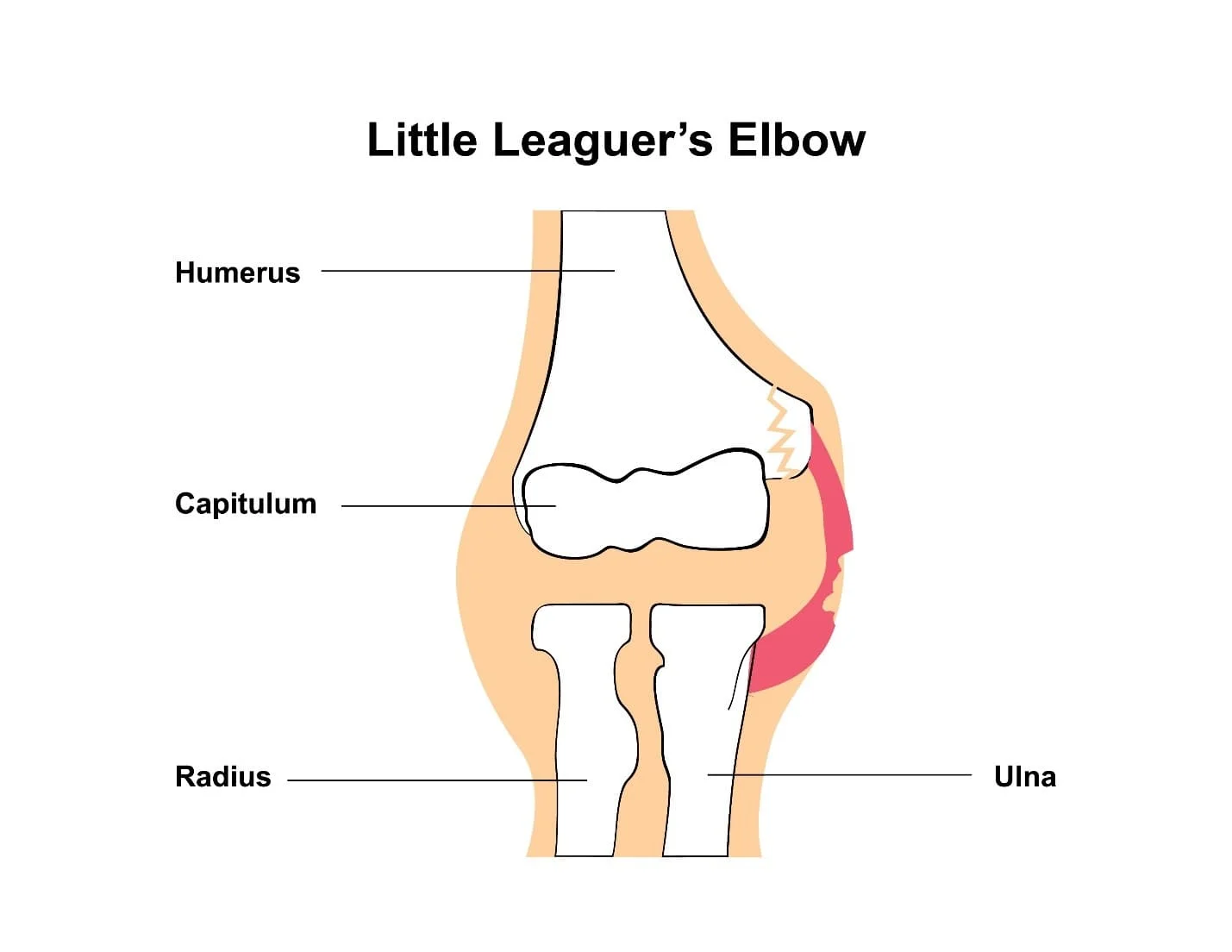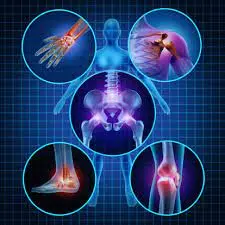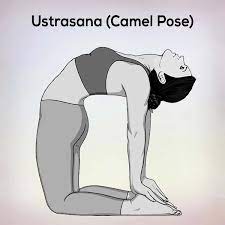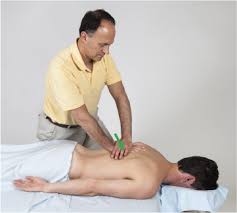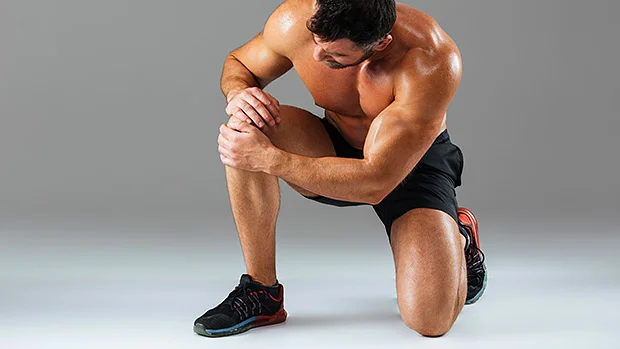Little League Elbow: Physiotherapy Treatment, Exercise
Table of Contents
What Is Little League Elbow?
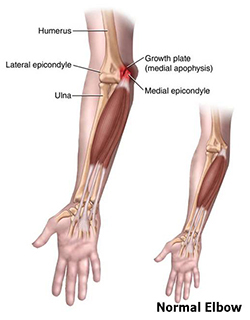
- It is the overuse to the injury of the elbow to repetitive throwing.
- Most of the cases happen in the pitchers, infielders, outfielders and catchers; but the young athlete who throw a lot can get the condition
- It is also result of the repetitive stress on the growth plate to inside of the elbow.
- This greatest stress become occurs during to acceleration phase of throwing to baseball.
- Growing bone is easily injure because of that growth plate is weaker than to ligaments and muscles which is attached to it.when the growth plate is fuse, athletes is more likely to injured ligaments and tendons instead.
- In this condition is a painful inflammation of the bony bump in the inside of the elbow.
- On this spot is the attachment site where the tendons of the muscles to bend the wrist & finger is located.
ANATOMY of the elbow:
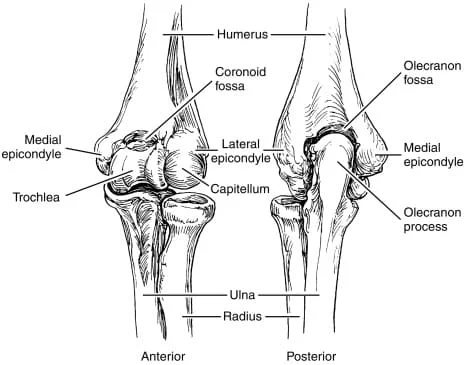
- Elbow joint is joint of three bones:
- Upper arm bone = humerus
- Two bones = in forearm = radius& ulna.
- Radius is on the lateral side [ outside] of the elbow when the ulna is on the medial side [ inside ] of the elbow & also includes the olecranon, it is on the tip of the elbow.
- The elbow joint is held together with the help of Muscles, ligaments, and tendons
- Elbow joint is two type of the joint [ hinge & a pivot ].
- Hinge part of the joint is lets to arm bend like as the hinge of the door;
- Pivot part is allows the lower arm for twist & rotate.
- Many muscles, nerves, tendons & connective tissues between muscles and bones are cross to the elbow.
- This all structure are contribute in stability & function of the elbow.
What Causes Little League Elbow?
- It is due to an overuse injury
- It is also called repetitive stress injury.
- Overuse injuries happen because to same motion is repeated again & again.
- It also occurs due to overuse of the muscles of the elbow &forearm.
- Do the activities without enough rest & recovery
Who Gets Little League Elbow?
- It is happens in most often in pitchers.
- Most of the cases are happen in the kids & teens of 8 to 15 years old.
- Over 20-30 years there is an increase for sport-related injuries;
Signs & Symptoms of the Little League Elbow?
- In Kids which have to problem of Little League elbow feel pain on the inner part of the elbow.
- In first time , the elbow is hurt only during or right after throwing , But without treatment, the elbow is started to hurting all the time.
- The pain is usually started gradually, but it become severe after repeat to same motions often.
- Athletes is experience to aching, sharp pain, & swelling on the inside of the elbow.
- Difficulty in straightening of the arm in all the way.
- Sometimes a bump appear on the inside of the elbow.
- Stiff or locked elbow.
Various sides of injuries in Little League Elbow:
Medial side injuries:
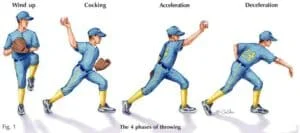
- In medial side related to valgus force overload in early & for throwing late cocking phases.
Presentation depends on age:
- For Younger Children =apophysitis
- For Older Children = epicondylar avulsion fracture
- For Not common to see = ligaments or flexor/pronator injuries in children
Signs/Symptoms:
- Elbow pain of medial side
- Decrease to speed or distance of throwing
- Effusion
- Point tenderness
- contractual of Flexion (note up to 15 degree)
Lateral side injuries :
- Early acceleration phase of throwing & Late cocking produces compressive forces.
- Shear forces is produced by the deceleration on the radio humeral joint.
- Examples = OCD of the capitellum or radial head, Panner’s disease
Panner’s disease Signs/Symptoms:
- Dull pain & activity-related pain in lateral
- Flexion contractual
- Self-limiting
- Minimal effusion
OCD Signs/Symtoms:
- Dull pain & activity-related pain in the lateral elbow.
- Insidious onset.
- Poorly localized pain.
- develop into locking,
- ROM decrease,
- flexion contractual >15 degrees.
Posterior injuries:
- Shearing forces is produced by the phases of throwing [ Acceleration and deceleration]
- For child athletes = Uncommon; for older children/adolescents = more common.
- In Injuries are include: olecranon apophysitis, avulsion fractures, posteriormedial impingement,.
Risk factors of the Little League Elbow?
- 80 pitches per game
- Competitive pitching per year for More than 8 months
- Speed of Fastball > 85 mph
- Continue pitching give to arm fatigue or pain
- Pitchers of Adolescent & throw repetitively adolescent players, have to high risk for developing little league elbow.
- If this condition untreated too many times, it can lead to major complications.
- Other factors which is that contribute to development of this condition & for the increase of injury rates which is seen in pediatric athlete including:
- Increase single-sport participation with year-round training
- Participation in higher intensity sports at younger ages
- Season of competitive
- Errors of conditioning & training
How Is Little League Elbow Diagnosed?
Radio graphs / x – rays:
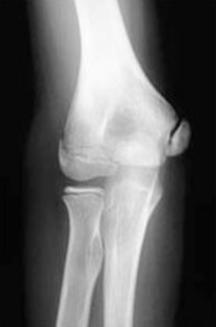
- Use recommended views like AP or lateral elbow.
- Findings =
- It shows the physical widening.
- It shows the fragmentation or avulsion of the medial epicondyle.
- It can also show bone problem, loose the bone chips & early arthritis.
MRI
- It will help to show increased edema of the medial epicondyle apophysis.
- It is also used confirm to UCL insufficiency.
How Is Little League Elbow Treated?
Conservative Management:
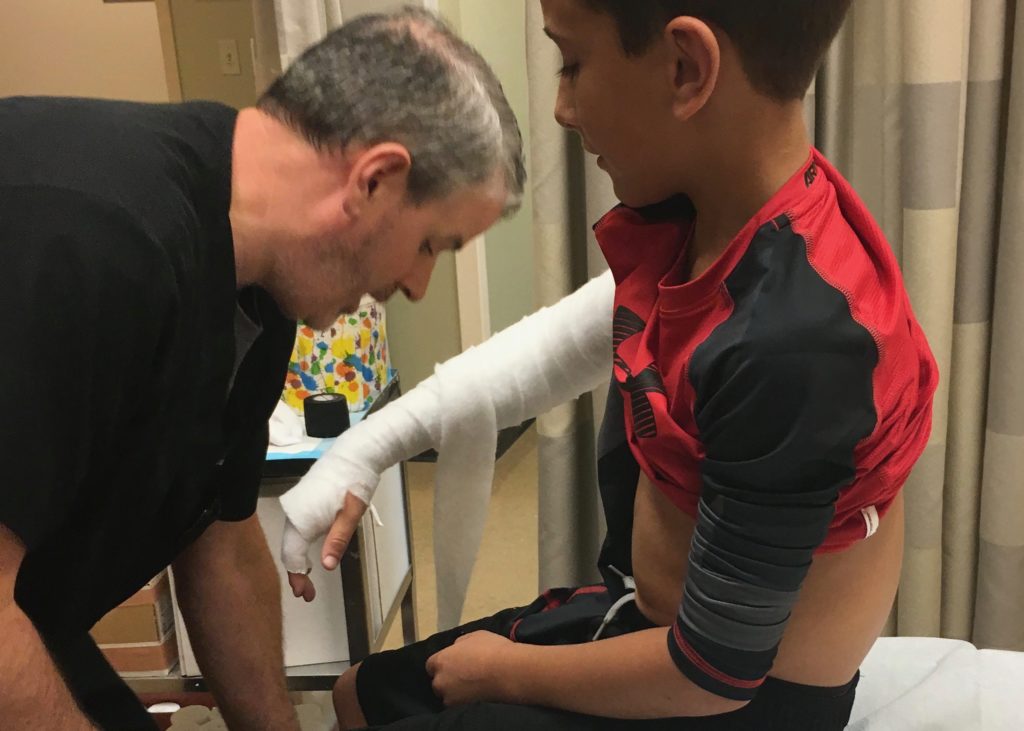
- Complete rest from throwing activities for a minimum 4-6 wk.
- Use to the ice.
- Use to the non-steroidal anti-inflammatory medication (NSAIDs) and ibuprofen drugs for pain relief ,
- Use to elbow extension brace when the flexion contractual is present.
- Apply to immobilization when the symptoms are severe.
Surgical treatment :
- It is rare for the young athlete need to surgery for the Little League Elbow.
- Surgical treatment is more beneficial than conservative management.
- Surgery is usually only recommended when the condition is present:
- Loose cartilaginous bodies
- Osteochondritis dissecans
- Avulsion fractures
- Surgery is also Depends upon to child’s injury
- like as removing loose bone fragments
- Bone grafting
- Reattaching a ligament back to the bone.
Examination of little league elbow by physiotherapy :
- The most common presenting complaint is pain, so the pain assignment is mast be required in the assignment check the duration of pain [ chronic or acute ]
- location of pain
- Type of the pain
- Severity scale
- In the observation check the overall alignment & carrying angle of the upper extremities.
- Check the presence of the swelling, atrophy, or hypertrophy
- Also check the Range of motion of the elbow and compare with the other hand [ elbow flexion, extension, pro-nation, and supination ]
- In the Palpation palpate the bony protuberances such as medial epicondyle, radiocapitellar joint & posterior olecranon apophysis It may reveal tenderness also check the Ligamentous stability.
- Physiotherapists is also check the neck, and affected side ipsilateral shoulder, and also check the neurological assessment, mostly to the ulnar nerve.
Exercise of Little League Elbow:
Rest:

- Rest for 4-6 weeks
- In this time patient is stop perform activities which is produce stresses in the medial elbow.
- Rest is help for decrease level of pain, duration of pain, and minimal pain.
- Immobilization is used only in cases of severe pain symptoms.
Early mobilization:
- In the early phase used medicine NSAID & principal of RICE [ rest, ice, compression, elevation ]
- ROM = Do the active movement of the wrist & elbow & Progress with the gentle pain-free PROM when the AROM is no longer painful.
- Give to patient mobilization with movement.
- Also apply to the nerve mobilizations.
- Therapist is give grade 3 and 4 mobilizations at the elbow and wrist joints to increase the ROM.
Eccentric exercises of elbow & wrist = load – low, repetitions high for promote localized circulation & correction of fiber.
- Orientation during tissue healing.
- Resisted exercises of the elbow & wrist with the use of the theraband or weights cuff.
- Throwing-specific exercises = Progress of the throwing protocol for one exercise to pain free.
Protocol of the ROM:
- After 2-6 weeks of post-injury start Immediate motion
- After 0-2 weeks: ROM (20-90) non-painful, start to Elbow and wrist AROM/PROM, in exercises include isometrics and shoulder stabilization exercises without IR/ER.
- Ice and compression are given in the intermediate phase.
- After 3-6 weeks: ROM to 135 degrees of elbow, in exercises including wrist curls, wrist movement, pronation/supination movement, biceps curl, triceps muscle exercise, shoulder ER/IR & adduction at the end of exercise give to Ice and compression.
- Weeks 7-12: Full ROM (Range of Motion) of the elbow and wrist. Resisted exercise of elbow and wrist, throwing-specific exercises.
- Progress to throwing protocol when exercises are pain-free.
Prevention :
For prevent form Little League elbow in young athletes:
- In a year take to break from throwing for 3–6 months.
- Athletes play other sports which in does not involve throwing such as soccer or swimming.
- In this age make sure athletes throw correctly.
- Athletes are also should follow to pitching guidelines :
- Athletes maintain fitness, physical fitness & conditioning.
- In this condition resistance exercise, strengthening exercise and aerobic exercise is important in whole life, so spend time on this whole exercise. do the Proper warm-up daily in warm-up such as stretching, running & gradual and easy throwing.
- Concentrate on the age-appropriate pitching.
- Avoid multiple teams pitching in overlapping seasons.
When the Kids With this condition go Back to throwing?
- After rest time,
- Physiotherapy treatment,
- In exercise programs, athletes slowly return to pitching from this condition,
- If do not have elbow pain.
- If they have full strength in their arm.
- If they bend and straighten their elbow fully.
- Throwing slowly increases for number, distance, & intensity of pitches over 6–8 weeks.
Throwing guidelines and protocol :
- The most important thing about this condition is that it can be prevented by throwing guidelines.
- This guidelines is help to stay healthy and when athletes returns to the sport.
| 9- to 10-year-old pitchers | 11- to 12-year-old pitchers | 13- to 14-year-old pitchers | |
| Game | 50 pitches | 75 pitches | 75 pitches |
| week | 75 pitches | 100 pitches | 125 pitches |
| Season | 1,000 pitches | 1,000 pitches | 1,000 pitches |
| Year | 2,000 pitches | 3,000 pitches | 3,000 pitches |
| Age 7 to 16 | Of pitchers |
| In a day pitchers | Time [ Rest ] |
| 61 or more | 4 days |
| 41-60 | 3 days |
| 21-40 | 2 days |
| 1-20 | 1 days |
| Age 17 to 18 | Of pitchers |
| In a day pitchers | Time [ Rest ] |
| 76 or more | 4 days |
| 51-75 | 3 days |
| 26-50 | 2 days |
| 1-25 | 1 days |
Conclusion
A class of elbow issues associated with young athletes’ stress from pitching is known as “little league elbow.” In addition to lateral and posterior symptoms, throwing can also produce medial symptoms. The repeated valgus distraction stresses on the medial elbow are linked to the medial symptoms. Injuries can result from microtrauma caused by misuse or poor throwing technique. In young baseball players in high school and college, pitching with arm fatigue on a regular basis, competing for more than eight months of the year, and averaging more than 80 pitches per appearance are the most common risk factors for elbow problems that necessitate surgery.
The question of when surgical intervention is required and whether it genuinely offers longer-term benefits over conservative care remains up for debate. Prevention by patient education and/or early diagnosis combined with appropriate treatment is, in all cases, the BEST course of action.

